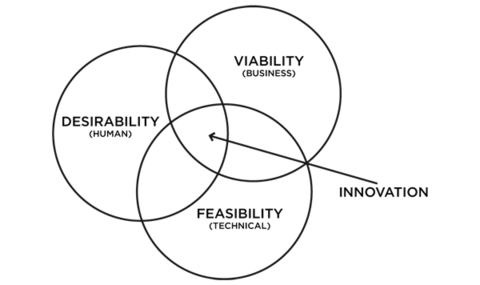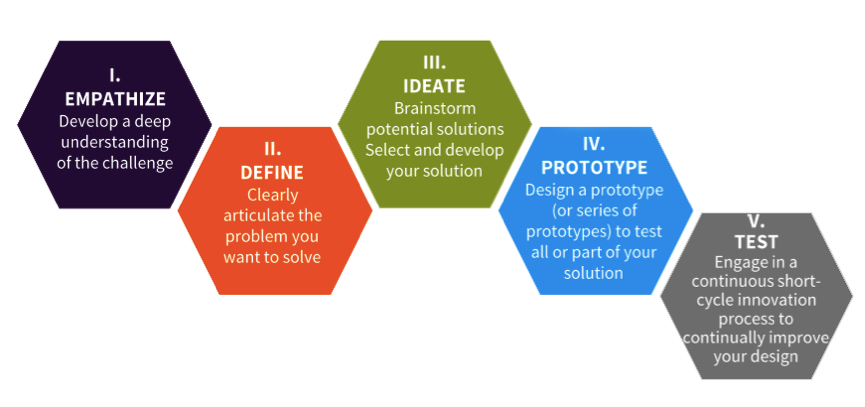What if there were some magic formula to innovate new products or services? Or some approach or method one can follow to be the next Elon Musk or Jeff Bezos?
Where there is no single “one-size-fits-all” approach to innovation, one such method focuses around people to arrive at new solutions – Design Thinking. This process or method is taught at Stanford d.school – “a place where people use design to develop their own creative potential”.
“Design thinking is a human-centred approach to innovation that draws from the designer’s toolkit to integrate the needs of people, the possibilities of technology, and the requirements for business success.” – Tim Brown, CEO OF IDEO
Getting to the Heart of Innovation
By using design thinking, innovators make decisions based around people and what they actually want, instead of relying on figures from historical data or instincts instead of hard evidence. We look first at the ‘desirability’ of the product – if this is something people want. We can do this through a series of interviews, by observation or experience. Key is putting yourself in your customer’s shoes, understanding how they would see things. Second is ‘feasibility’ – if the product technically works. If your product doesn’t work then it’s no use to anybody. Third is ‘viability’ – whether you have a viable business model i.e. whether anyone will by your product and if it is economically viable. At the heart of all this is innovation.

Often it is all too easy for engineers to focus on the technical side but they completely forget the user interface (‘desirability’) and whether there is actually a market for their idea (‘viability’). In order to be a successful innovator, a combination of all three is needed.
Five-step Approach to Design Thinking
IDEO breaks this down even further to several phases to first ‘develop a deep understanding of the challenge’ (empathize) – the human element before working on the technical solution (ideate/protoype) and testing it on potential customers. Following the

- Empathise – put yourself in the shoes of your potential customer and see things through their eyes. You can build empathy through interviews, observation and experience.
- Define – revisit the initial design challenge and start to define the problem you want to solve.
- Ideate – brainstorm potential solutions, select and develop your solution. This can be done in two phases: Diverge (create choices) – follow some simple rules of brainstorming. Converge (make choices): select the ideas you want to work on.
- Protoype – Build to think and feel. Transform your idea into something tangible. Think about “what could it be?”, “what should it be?”, “what will it be?”
- Test – test your prototype and learn more about your customer to refine your product. You should use analytics to validate different approaches.
A Virtual Crash Course In Design Thinking
d.school created an online version of one of their most frequently sought after learning tools – their Virtual Crash Course. Here they explain the basic principles of design thinking so you can start to adapt them into your personal and professional routines. They run you through a 90-minute experience where you are taken through a full design cycle by participating in an example project. See the video below.
Unlock Your Creativity!
In the first event of its kind in Europe, INNOspace Weekend, takes its influences from Startup Weekend and integrates design thinking and other processes to enable creative innovation. Participants will get a feel for this process through a series of activities structured around this five-step approach.
The participants will first meet with experts in each of the three focus areas of space, automotive and logistics to explore them first-hand, ask questions and develop a deep understanding of 5 key trending topics of each sector (Stage 1). The answers generated from our tour partners will be used as ideas for an in-depth design thinking workshop in the afternoon (Stage 2) by Angeliki Kapaglou, who has trained at the Stanford d.school and has previously worked with JPL’s Innovation Foundry on design methodologies for early space mission concept formulation . Following a vote on the best initial ideas, the participants will form teams and then build on the idea (Stage 3). Hands-on resources will be made available where the teams can build a prototype of their idea into something tangible (Stage 4), that they can later test (Stage 5). We hope participants will be able to test their ideas at least once in this intensive weekend before they present their business concept to a panel of judges.
Other recommended reading:
- Design Thinking (Ideo)
- Design Thinking… What Is That? (Fast Company)
- Design Thinking: A Manual for Innovation (Demien Borba)

